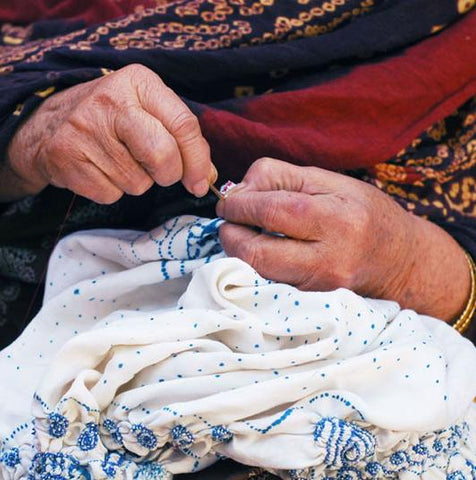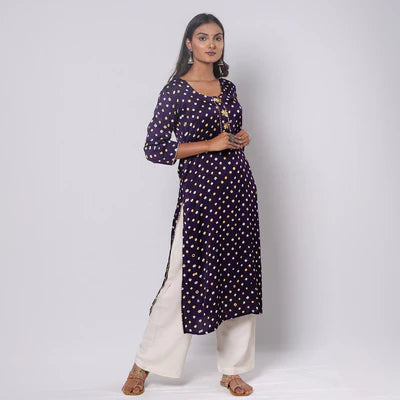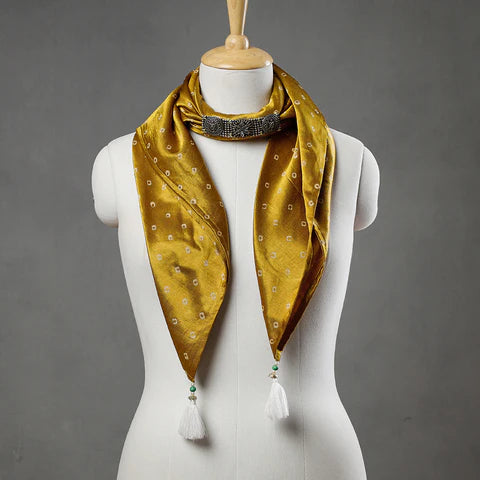History of Bandhani Tie & Dye
Vivid colors, gorgeous patterns and vibrant additions to any outfit. With these adjectives come to mind the word Bandhani. Bandhani (ban-dh-ni) tie and dye is a process of fabric art or textile decoration, that is done by pinching the piece of cloth with fingernails into many tiny bindings that form a visual design. This requires a high skill set as it is a difficult process to conduct and needs the best artisans at work. Originating from the Sanskrit word “bandh” which means tie, it is both metaphoric and symbolic of its name, and is one of the most sought after forms of textile designs in India. Representative of the desert regions of Rajasthan and Gujarat, these prints have made quite a mark in the textile industry.
Here is a short piece to introduce you to the magic of this style, and hope you rush to get your own piece soon !
Details of the Bandhani Tie and Dye Art Form
Most bandhani centers of India are located in the regions of Gujarat and Rajasthan, along with the Sindh and Punjab region, but it is also very prevalent in the country of Pakistan. The first evidence of Bandhani was seen back in the age of the Indus Valley Civilization, where there were traces of fabric dyeing performed as early as in 4000 BC. There have also been mentions of the art in the texts of Alexander the Great, where he elaborates on the beautiful and elegant printed cottons of India. Since then, it has maintained its position as one of the forerunning textile designs of the country. The Khatri community of Kutch and Saurashtra exclusively carry out this art form, where meters of cloth have undergone this process of tie and dye and had hundreds of tiny knots, known as ‘beendni’ in the regional language.

{Image source- D'source}
Bandhani prints have multiple names by which it goes, some of them being Piliya, Chungidi, Shikari and even Bandhej Saree, depending on the region and the dialect of the community. The process of tie and dye starts with dyeing a fabric or cloth that is tightly tied with a thread at multiple points. The way the thread is tied determines the design of the fabric, and this gives enough leeway to the artisans to experiment with and form an array of designs and patterns. Usually, the tying of the knots are done with fingernails, but in some areas of Rajasthan, the artisans wear metal rings with a point top to help pluck the cloth easily.
Explore Bandhani - Bandhej Sarees Online
Bandhani Sarees – Banarasi, Silk, Cotton & More
The New Take On The Bandhani Art In Today’s World
Through the years, there have been multiple different experiments of the binding and tying techniques to form patterns and designs, but in the end they have found the ones that are here to stay. The main colors that are usually used for Bandhani prints are yellow, blue, red, black and even green. These dyes are natural and the process of dyeing is done by hand, allowing some of the best combinations of the colors too.

Image credit:- d'source
Bandhani is known to be a generational art form, and is one that is passed on through families along centuries. It works as a family trade, where the women of the household perform the dyeing process, and then the fabrics are later sold.
Some of the main cities of Gujarat, where Bandhani is created are, Rajkot, Mandavi, Jamnagar among others. The famous city of Bhuj is well known for its traditional red bandhani pieces. This city is also acclaimed for the water that runs through the area, and is said to give a particular sheen and brightness to the color, specifically those in the shades of red and maroon.
Future of the art:
Over the past few decades, the demand for Bandhani has increased massively, and there is a craving for surpluses of the same in markets. Adorned by people mainly during the seasons of festivities, these prints have become quite famous. The major chunk of this market is mainly in the state of Gujarat. The demand for the art in today’s world has resulted in the start of new stitching techniques and designs. These explore more versatile styles and designs, while showcasing a more innovative outlook. Various local communities have started shifting away from the legacy of pursuing this art from, but many of the designers and stylists of the fashion industry over the Indian subcontinent have also started picking up Bandhani pieces to showcase and work new collections on. It is versatile and elegant, and perfectly fits the needs of the wearer.
Today Bandhani is used as cloth for turbans, kurta’s, dupattas and even bags. Even the color palette of the tie and dye have diversified, to shades of beige, purple and even pinks.
xplore Bandhani Fabric Material: Traditional & Stylish Choices
Traditional Bandhej Prints with a Modern Twist
iTokri And Its Affiliation With Bandhani:
iTokri is a big supporter of the Badhani art, and has an array of fabric products on their website for the customers to choose from! Bandhani kurtas have become a big hit over the past couple of years and are in high demand. Our website has a collection of kurtas, with the color scheme ranging far and wide.
Come check out the collection of Bandhani products on Itokri. Bandhani designs allow our customers to experience a touch of the artistic culture that has been passed on in the Indian states, for an array of generations, and in the modern and fast-changing world, it keeps alive a little bit of tradition.

The cloth designed by bandhani prints look elegant, and one of a kind, lighting up anyone and their outfit when they adorn it. Itokri supplies modal silk, as well as cotton tie-dye bandhani kurtis, as well as brings in traditional Kutch bandhani kurtis for the customers. There is also a collection of bandhani blouses, bandhani stoles ,and pre-cut clothes.

Other uses of Bandhani:
Bandhani fabric can be used for cushion covers, or for other home decorative uses. Bandhani home decor has been gaining popularity in the past couple of months, and is chosen to make one’s home look more trendy and out of the box. The patterns add a touch of color to any room, and the patterns and designs speak loudly of the elegance and delicacy of the handiwork that is performed by the artisans. A lot of bandhani cloths are also used as shades for lamps, or to cover some decorative home pieces and furniture. The vibrant colors and patterns, that are via multiple products on our website, are high in demand by the modern industries. sold Bandhani prints are now sold in even pre-cut cloth, and these fabrics can be bought to get any item that one desires made by one’s choice.
Faqs
- What does Bandhani symbolize?
Bandhani sarees are generally a tye-dye textile, practised mainly in states like Rajasthan, Gujarat, and in states of Uttar Pradesh. It is even said that wearing a bandhani saree can bring good luck and fortune to the bride.
- Where does the Bandhani art of tie and dye belong?
The Bandhani art of tie and dye belongs to Gujarat, especially the red Bandhani. It is also even practised in Rajasthan, a state in India.
- What is special about Bandhani?
Bandhani is one of the oldest known methods of tie-dyeing; They are still practised in western India today. The Bandhani fabric is made by initially from small portions of cloth and tying them by plucking the cloth with the fingernails into many tiny bindings to form an intricate pattern of dots.
- Are bandhani and bandhej same?
Yes, Bandhani and Bandhej are same. The name Bandhani is derived from the Sanskrit term, which means tying a craft.
- What is the difference between Bandhani of Gujarat and Rajasthan?
There are quite a lot of differences in the colours when it comes to bandhani wear made in Gujarat and Rajasthan. Also, the designs are also different in both areas.
Shop Bandhani Tie-Dye Dress Materials
from Kutch





































Leave a comment (all fields required)